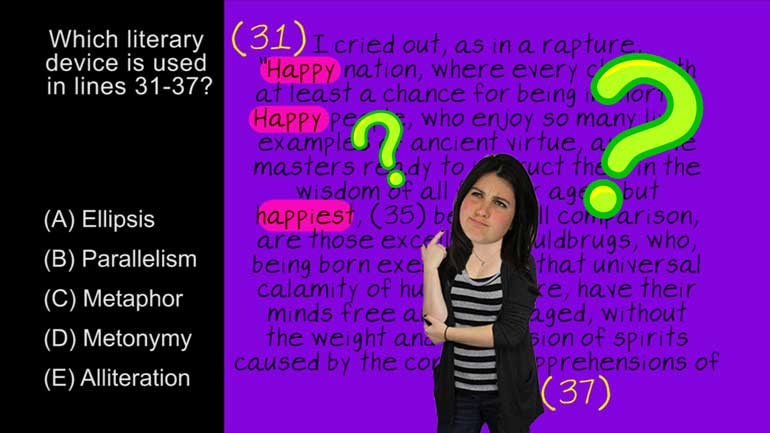ShmoopTube
Where Monty Python meets your 10th grade teacher.
Search Thousands of Shmoop Videos
AP Physics B 1.1 Newtonian Mechanics 193 Views
Share It!
Description:
Newtonian Mechanics Drill 1, Question 1. What is the magnitude of the constant acceleration due to the mud?
Transcript
- 00:04
Gettin' shmoopy with it...
- 00:06
You are carefully carrying your father's 15 kilogram bowling ball across a muddy field when you drop it.
- 00:11
Heaven only knows where you were going with it. If it falls 1 meter, and the ball sinks into
- 00:16
the mud to a depth of 10 centimeters, what is the magnitude of the constant acceleration
- 00:22
due to the mud? And here are the possible answers...
Full Transcript
- 00:28
First of all, that's a heavy bowling ball, and you're lucky it didn't fall on your feet.
- 00:32
Now, onto physics. This problem takes place in two parts.
- 00:36
First, you drop the ball, and it falls to the mud below.
- 00:38
Then, once it lands, the mud pushes back on the bowling ball, and stops it.
- 00:43
Let's start by looking at the falling portion of this problem.
- 00:47
When the bowling ball first begins to drop, it's in free-fall, and it follows all of
- 00:51
the rules associated with free-fall. Like... waving its arms over its head and screaming.
- 00:58
Remember that in kinematics, we have a few key terms:
- 01:01
Displacement is the distance between an object and its original location.
- 01:07
Velocity is the speed of the object in a particular direction.
- 01:11
We find velocity by dividing the
- 01:12
object's displacement by the time it took for it to move that far.
- 01:17
Finally, acceleration is how fast the object is changing its velocity.
- 01:24
In this problem, initial velocity is 0, starting displacement is 0 meters, final displacement
- 01:30
is 1 meter, acceleration is 10 meters per second squared, and the time is... irrelevant.
- 01:37
For this problem, anyway. The final velocity, which is left over, is
- 01:41
what we're trying to find. To do that, we call upon the power of our
- 01:44
kinematics equations. In particular, v sub f squared equals nought squared plus 2a times
- 01:52
the quantity x sub f minus x sub zero. Since v nought and X nought = 0 we can make
- 02:00
those terms go away, and only worry about v sub f, A, and x sub f.
- 02:05
We can plug in the values we know for a and x, or we could substitute in variables.
- 02:10
If we went the latter route, we would find that sub f squared equals 2gh, where g is
- 02:16
equal to the acceleration due to gravity or 10 meters per second squared, and h is the
- 02:21
height the bowling ball will fall.
- 02:24
Taking the square root of both sides,
- 02:25
we get that v sub f equals the square root of 2ax sub f.
- 02:30
Phew, that was exhausting, and we're only half done.
- 02:33
Fight through the pain.
- 02:36
Once the ball finishes dropping, it begins
- 02:38
slowing down because of the mud. The final velocity will be 0, because the
- 02:43
ball has stopped moving. Again, we assume that the beginning of the ball's movement
- 02:46
is displacement = 0, and the final is .1 meters, because the ball sinks in .1 meters.
- 02:56
Time is again, irrelevant, but we're missing both acceleration and initial velocity.
- 03:01
But wait! In the first part, we found out what the initial velocity was. It's √2gh.
- 03:09
Great. Now, just like in the first part, we take the equation v sub f squared = v nought
- 03:14
squared + 2a times the quantity x sub f minus x nought... and plug in what we know.
- 03:23
If we left out the actual values of g and h, now is the time to plug them in.
- 03:27
Now's the hard part. We have to do Algebra. Wince.
- 03:31
First we do all of the multiplication we can, and get 20 plus .2a is equal to 0.
- 03:37
Next, we move the 20 over to the other side of the equation by subtracting,
- 03:42
and finally, divide by .2.
- 03:45
Our answer is negative, and none of the answer
- 03:47
choices are negative. Did we make a mistake? Actually, we didn't.
- 03:51
In physics, negative signs usually indicate direction. For example, if moving to the right
- 03:56
was positive displacement, then a negative value would be moving to the left.
- 04:00
In this case, the negative values just mean that the acceleration is opposite our velocity,
- 04:05
which was downwards. If we think of up as positive, then our answer
- 04:09
would be 100 meters per second squared... ...or answer D.
- 04:13
Of course, none of this really matters... since your dad's gonna kill you when he
- 04:16
finds out you took his nice bowling ball.
Up Next
When you're about to marry the love of your life, not many things could stop you. However, finding out that your future hubby is keeping his crazy...
Related Videos
Here at Shmoop, we work for kids, not just the bottom line. Founded by David Siminoff and his wife Ellen Siminoff, Shmoop was originally conceived...
ACT Math: Elementary Algebra Drill 4, Problem 5. What is the solution to the problem shown?
AP® English Literature and Composition Passage Drill 1, Problem 1. Which literary device is used in lines 31 to 37?
AP® English Literature and Composition Passage Drill 2, Problem 1. What claim does Bacon make that contradicts the maxim "Whatsoever is delig...




